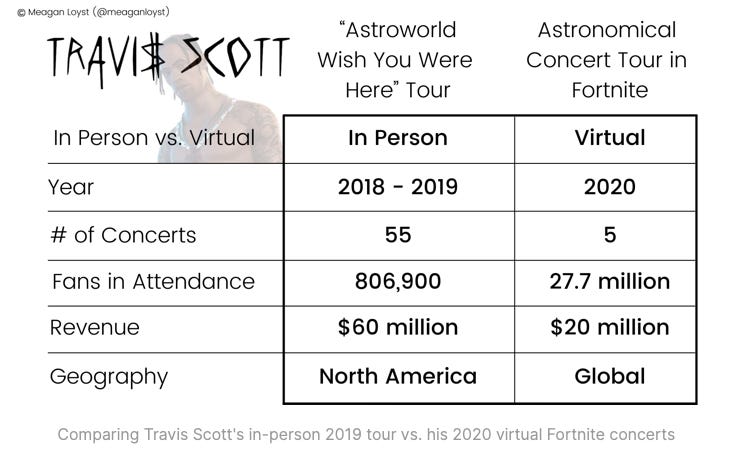Metaverse, Inc. - An Introduction
When we started the MetaPortal newsletter in April of 2021, it was meant mostly for holders of the Metaverse Index, MVI. We wanted to talk about some of our macro views underpinning the Metaverse thesis, like advantages of NFT gaming or Metaverse as the future of work, as well as dive deeper into individual tokens.
Recently, we have been evolving our content, together with the much broader vision for MetaPortal as a brand. As part of the content evolution, we want to try out a new angle focusing on Metaverse-related developments in the traditional corporate world. Think Roblox, not Axie.
There are two extremes in how the Metaverse might play out. One is the extension of the current status quo, where platforms are in control, systems are closed and permissioned, data is harvested and rent seeking is the predominant business model. The alternative is a fully open and interoperable world powered by blockchain, NFTs and other open-source tech. However, there’s a spectrum of outcomes in between these two extremes. We will need hardware (Oculus, PlayStation), computation (AWS), storage, rendering, gaming engines (Unity, Unreal) and so on. Some of these tools will remain centralized.
With that in mind, we think it’s important to stay on top of the traditional corporate world and things they are building to power the Metaverse.
Squidbit will kick us off with the first article in what we are calling the “Metaverse, Inc.” series.
- AG
Although the Metaverse has been “a thing” for years, it violently came into the fore in 2021 with Meta’s (formerly known as Facebook) announcement it was rebranding around this budding digital universe. Since then, after only a few short months of mainstream conversation, the world at large has apparently reached consensus that the Metaverse as a long-term concept is here to stay.
Flows into Metaverse-themed ETFs verify this sentiment with one of the most popular products recently reaching more than $920 million in assets under management. With the promise to blend both the digital and physical worlds in ways that unlock new levels of creativity, productivity, socialization, ownership and fun, it’s no wonder people from all different backgrounds have come together to build the Metaverse.
AG and DarkForestCapital have written about many of the crypto-native ways the Metaverse can—and in our opinion should—evolve (read some great examples here, here and here). And as you know, we’ve even designed a token index $MVI to broadly track the space. However, significant portions of the underlying infrastructure for the Metaverse are being built off-chain. Companies like Meta, NVIDIA, and many others are dedicating meaningful resources to building the bedrock technologies that will enable a wide variety of new shared virtual experiences.
The Builders
To get a feel for what’s going on in the physical world in order to create the meta world, let’s start with a look at two traditional companies currently building in the space. This list is by no means exhaustive and if you want to highlight other groups outside crypto working on interesting projects, please share!
Meta
On October 28, 2021 Facebook ($FB | $MVRS) announced a re-branding focused on the company’s two principal priorities: 1) it’s existing family of apps (Facebook, Instagram, and WhatsApp) and 2) augmented reality / virtual reality (Reality Labs). Obviously, the latter is where Meta envisions most of its contributions to the Metaverse to originate.
The genesis of Reality Labs began in 2014 when Meta acquired Oculus VR. This transaction not only offered the company exposure to novel hardware for gaming, but also gave Meta a foothold in what it foresaw as a transformative medium of human communication. Not coincidentally, the Oculus acquisition also provided Meta a means to control entry into its own closed VR marketplace where it can charge admission to access its platform, similar to other ecosystem-centric technology companies like Apple or Google. Since 2014, Meta has become a household name in VR and for the first time in 2021 sold more Oculus 2 headsets than Microsoft sold Xboxes.


But Meta is not just in the business of mass-producing VR headsets, the company is spending billions on other hardware, software and content for the metaverse that is objectively interesting.
Take, for instance, the group that is working to create a haptic glove that allows users to feel touch during virtual experiences. Or the team that is developing AI systems to enable the creation of codec avatars—quickly constructed virtual representations of our physical forms for use in remote social environments. Watch any part of Meta’s aspirational yet awkward Connect 2021 film and it’s clear the company has high hopes for its future contributions to the Metaverse.
Unfortunately, Meta retains the overwhelming incentive to produce its wares in a manner that revolves around ads and privacy infringement. Funnily enough, when trying to view the video about the company’s haptic glove, I was prompted to grant the website access to track my data...gross.
Although Meta claims its rebranding comes with a more open approach to creating tools for the future, the financial rewards for continuing to simply serve ads to its user base are powerful. According to Meta’s most recent SEC filing, less than 3% of its average quarterly revenue of $29 billion comes from sources not linked to advertising.
Shady business practices aside, it is likely Meta’s current and future investments, size, and pure spending power will yield the company a considerable corner of the Metaverse.
NVIDIA
Perhaps best known for its production of computer processors (primarily GPUs), NVIDIA ($NVDA) is another company developing formative technologies that are the digital bricks and mortar needed to actually build the Metaverse. Many of its products are already used in the creation of virtual worlds. NVIDIA’s Omniverse engine is the powerhouse behind many enterprise-level 3D rendering projects. Omniverse and other related NVIDIA products are used in everything from geo-mapping, to infrastructure engineering, to gaming.
Despite NVIDIA already enjoying widespread adoption of its solutions, the company is also looking to expand the usage of its Omniverse engine to more than just enterprise developers and at CES—hosted just a couple weeks ago—NVIDIA announced it would offer a free version of Omniverse to everyday creators.
What’s more, NVIDIA isn’t alone in the real-time 3D space. Unity Software ($U) and Epic Games’ Unreal Engine are two other prominent companies with similar capabilities working to provide tools for professional creators to make amazing virtual designs. These three companies have even begun offering ways for developers to collaborate across their platforms.
Alongside Meta, NVIDIA’s unique hardware and software offerings put the company firmly in the “must watch” category for off-chain development of the Metaverse.
There’s more
Aside from both of the companies listed above, there are many other groups building really exciting things that are likely to inspire early versions of the Metaverse.
It goes without saying that the gaming industry is already pioneering many of these experiences. For example, in-game events and concerts have captured the attention of players and non-players alike as these virtual experiences provide novel ways for fans to interact with their favorite artists. They also come with highly attractive unit economics.
Gaming environments have also increasingly focused on user-generated content, resulting in vast libraries of unique gameplay options. For platforms like Fortnite and Roblox, user-generated content has also spurred the evolution of creator economies where game developers can earn income from their creations. It’s somewhat unclear that this model is actually providing real value to a high number of users, however (for a shocking look at some of the problems with the creator economy on Roblox specifically, here is a fascinating exposé).
But trailblazing metaversial work isn’t limited to gaming. Outside of that industry, other primarily non-crypto firms have also focused on engineering better environments for virtual work (check out Gather.town), virtual clothing and accessories (remember this digital handbag that sold for more on Roblox than it cost in real life?), or virtual identity (take a look at Genies).
Next up
All-in-all, the metaverse is brimming over with interest, investment, and development both on and off the blockchain and expectations are high for whatever comes next. In the next piece covering Metaverse, Inc., we plan to dive more deeply into extended reality and the hardware and software that powers these experiences. In future writings, we also will share more on the less heard-of companies in the physical world building the key components of the Metaverse. No doubt there is lots to cover so if you have any specific yearnings for knowledge on non-crypto Metaverse topics, feel free to make them known. Thanks for reading and catch you next time.





